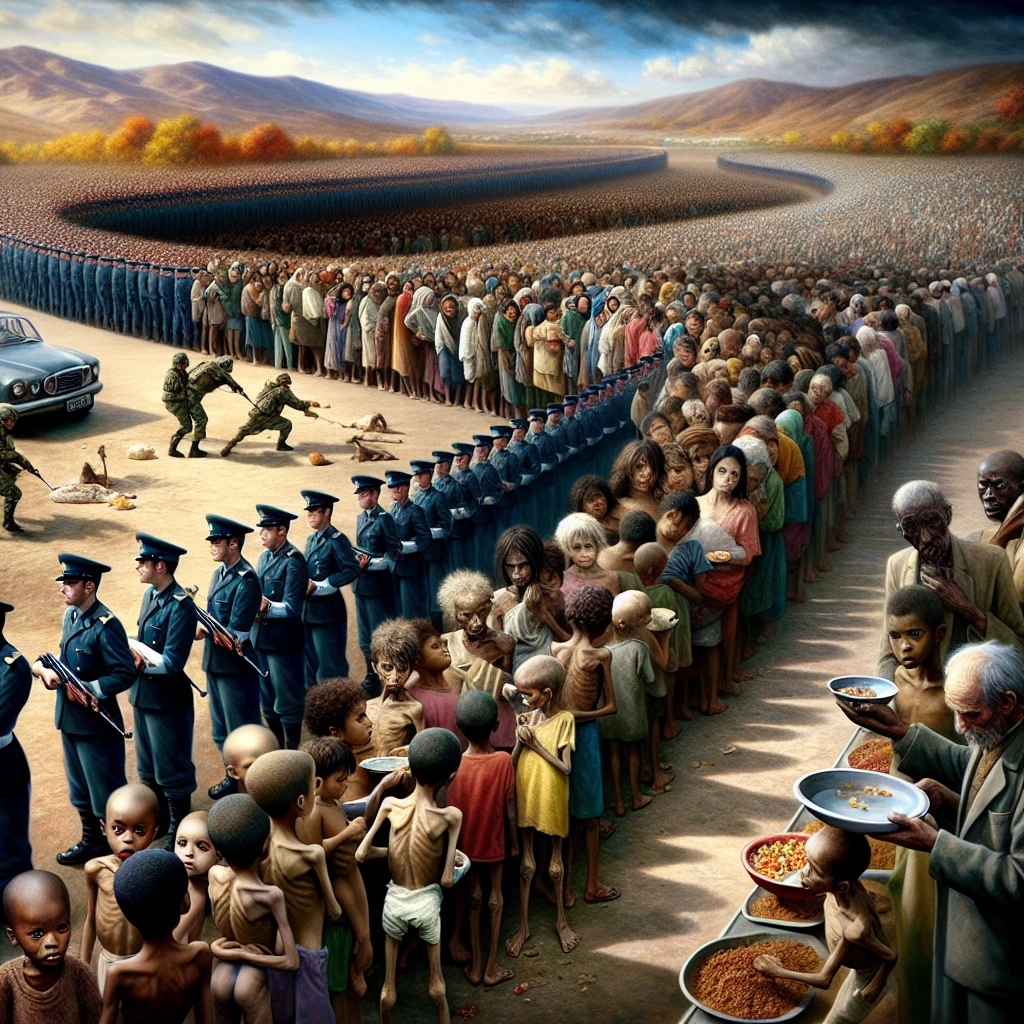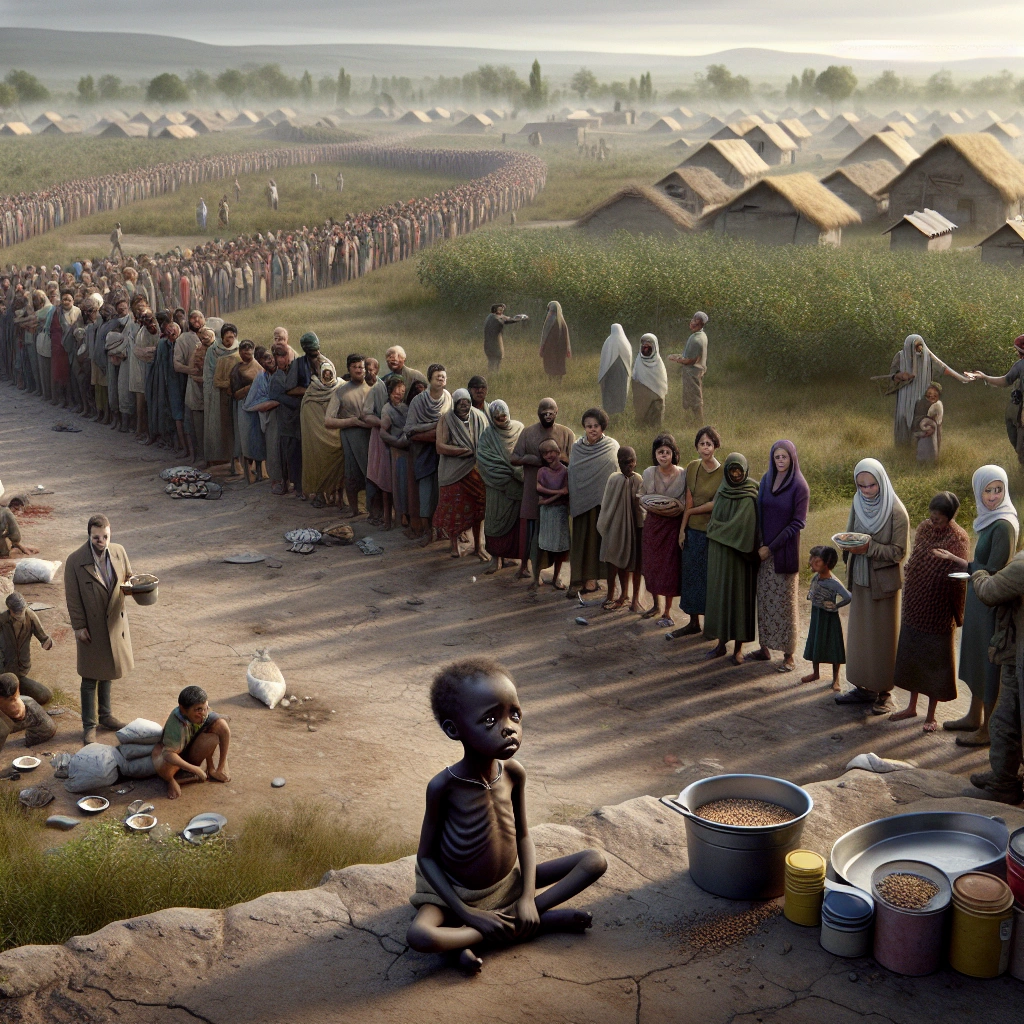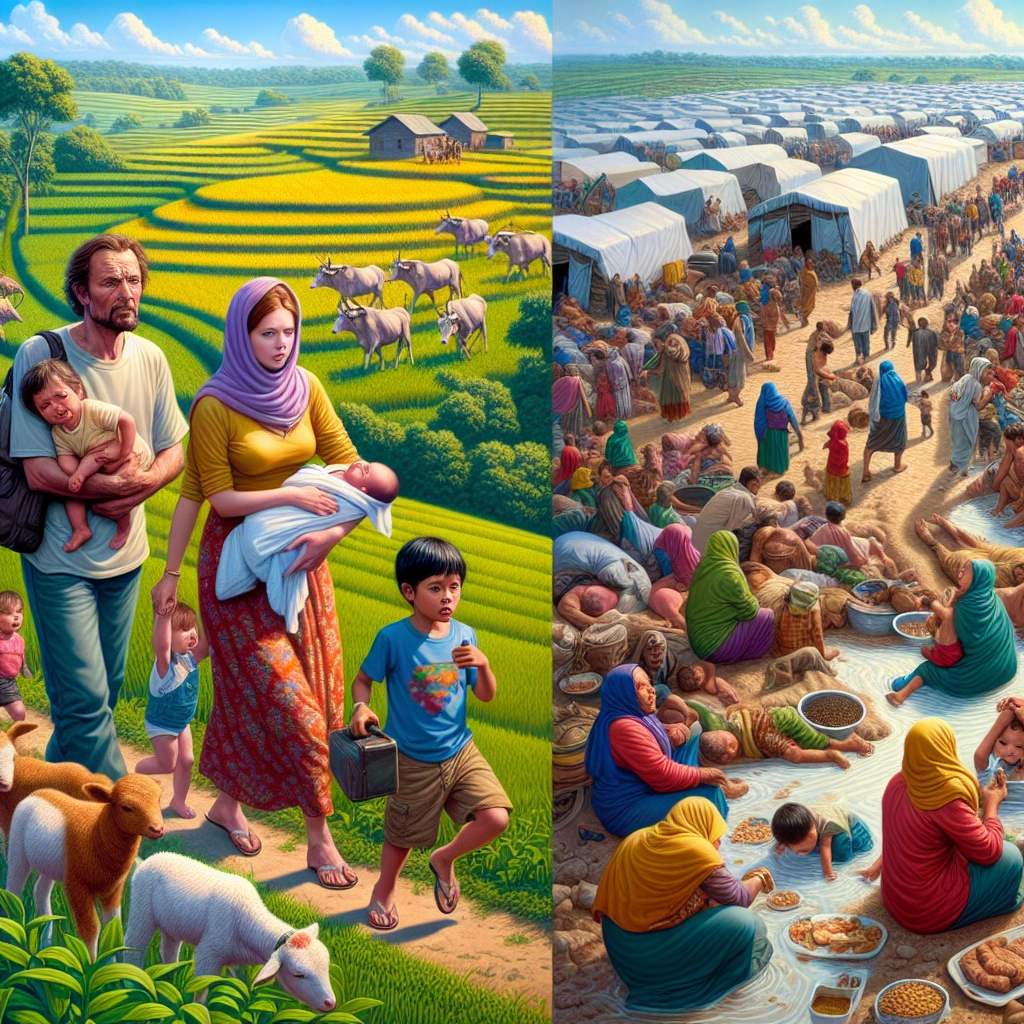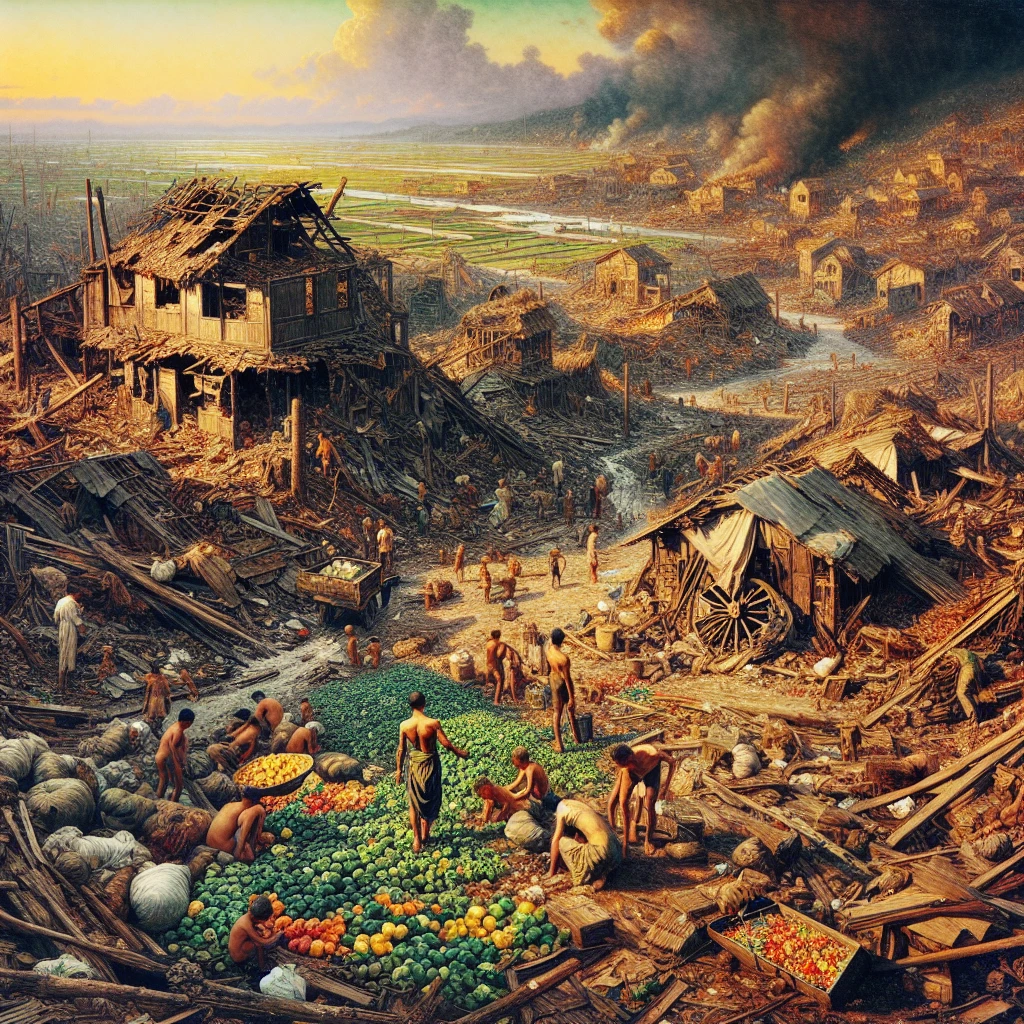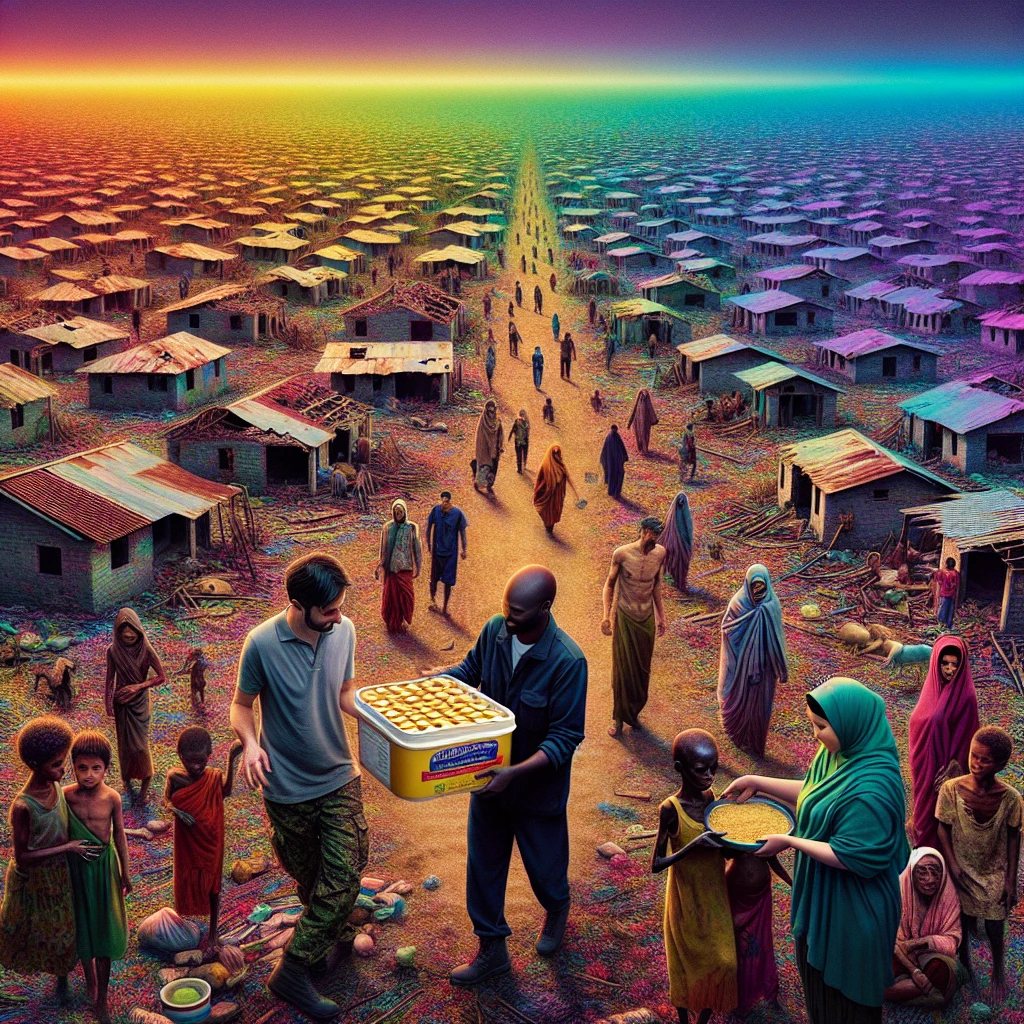

Conflict and hunger are closely linked, as conflicts can disrupt food production, distribution, and access to food, leading to food shortages and insecurity. The impact of conflict on food security can result in the destruction of food supplies, agricultural infrastructure, and displacement of communities, exacerbating the unaffordability of healthy diets.
Furthermore, conflicts can directly and indirectly impact entire food systems, making it difficult for affected populations to access the food they need for survival.
Check out this Youtube video: “How Conflict Causes Food Insecurity – YouTube” to gain insight into how conflict contributes to hunger and food insecurity around the world.
The Impact of Conflict on Food Production
Disruption of agricultural activities
Warring factions often engage in the deliberate destruction of agricultural infrastructure, including farmlands, irrigation systems, and machinery, resulting in a significant disruption of agricultural activities. This disruption leads to decreased crop yields, limited access to arable land, and reduced investment in agricultural development, ultimately contributing to food scarcity and hunger in conflict-affected regions.
Destruction of crops and livestock
In areas engulfed by conflict, the intentional destruction of crops and livestock by warring parties exacerbates food insecurity and hunger. Livelihoods dependent on agriculture are devastated as the destruction of vital food sources leads to acute shortages.
This destruction amplifies the vulnerability of communities to famine, exacerbating the already dire impact of conflict on food production and availability.
| Disruption of Agricultural Activities | Destruction of Crops and Livestock |
|---|---|
| Deliberate destruction of farmlands, irrigation systems, and machinery | Intentional destruction of crops and livestock by warring factions |
| Leads to decreased crop yields, limited access to arable land, and reduced investment in agricultural development | Exacerbates food insecurity and hunger, devastating livelihoods dependent on agriculture |
In conflict-affected regions, the detrimental impact of disrupted agricultural activities and the destruction of crops and livestock perpetuates the cycle of food insecurity and hunger, imposing severe challenges on the survival of entire populations.
Impacts on Food Distribution and Access
Disruption of supply chains
Supply chains disruptions occur due to conflicts, leading to logistical challenges in delivering food to affected regions. For example, in war-torn areas, transportation routes may be blocked or unsafe, hindering the movement of essential food supplies to the people in need.
Increased food prices
Conflict can lead to inflationary pressures on food prices due to reduced agricultural production and increased demand for emergency aid. Restrictions on trade and destruction of farmland further exacerbate the scarcity of food, resulting in higher prices for the available limited supply.
Limited access to food and markets
In conflict zones, limited access to food and markets is prevalent as ongoing violence restricts movement, making it challenging for individuals to reach markets or food distribution points. This limitation significantly impacts the ability of communities to obtain necessary sustenance.
Displacement and Food Insecurity
Forced migration and refugee crisis
- In areas experiencing conflict, forced migration and refugee crises often occur as a result.
- The upheaval caused by violence, persecution, and armed conflict forces people to leave their homes and seek refuge in other areas or countries.
- This displacement disrupts their access to food sources, leading to increased food insecurity among these displaced populations.
Overcrowded and under-resourced refugee camps
- As a consequence of forced migration, individuals often find themselves in overcrowded and under-resourced refugee camps.
- These camps struggle to provide adequate food supplies and resources to meet the needs of the large influx of displaced individuals.
- The sheer volume of people in these camps can lead to a scarcity of food, resulting in heightened levels of food insecurity and malnutrition among the refugee population.
| Challenges Faced by Refugee Camps | Impact on Food Security |
|---|---|
| Overcrowding | Scarcity of Food Resources |
| Limited Resources | Heightened Food Insecurity Levels |
Conflict-induced displacement not only results in a refugee crisis but also contributes to severe food insecurity and malnutrition among displaced populations, particularly in overcrowded and under-resourced refugee camps.
Nutrition and Health Consequences
Malnutrition
Malnutrition, a result of inadequate nutrient intake or absorption issues, is prevalent in populations with low income and limited access to suitable dietary choices. This deficiency leads to diverse immune system changes, repressing immune responses and increasing vulnerability to infections and diseases. Furthermore, malnutrition can directly impact tissue function, leading to serious health issues such as stunted growth, eye problems, diabetes, and heart disease. The interleukin-1 receptor (IL-1R) family, encompassing 10 cytokines and receptors, has essential roles in infection, inflammation, and immunity. A deficiency in these can prove detrimental for the body’s defense against diseases.
Increased Vulnerability to Diseases
Considering malnutrition’s impact on immunity, vulnerable populations are more susceptible to a range of diseases due to the compromised immune system. The relationship between nutrition and the immune system is critical, as optimal gut health and nutrient-filled diets are essential for improved immunity against infections and diseases.
Reduced dietary intake, malabsorption, altered metabolic demands, and increased nutrient losses can lead to wide-ranging changes in physiological function, resulting in increased rates of morbidity and mortality. Consequently, there is a need for concerted efforts to address malnutrition and its repercussions.
| Key Points | Implications |
|---|---|
| Inadequate nutrient intake or absorption | Diverse immune system changes |
| Impact on tissue function with health issues | Vulnerability to diseases |
| Optimal gut health and nutrient-filled diets | Wide-ranging changes in physiological function |
Economic Consequences
Loss of livelihoods
The impact of conflict on livelihoods is severe, leading to the disruption and destruction of communities and businesses. Families lose their sources of income and face economic instability, making it challenging to afford basic necessities, including food.
Conflict can result in the displacement of individuals from their homes, further exacerbating the loss of livelihoods and access to resources for sustenance.
Decreased purchasing power for food
As conflict persists, the purchasing power of communities diminishes, affecting their ability to access an adequate and nutritious food supply. Inflation, economic instability, and disrupted supply chains contribute to rising food prices, making it increasingly difficult for individuals to afford essential food items.
The decreased purchasing power further intensifies food insecurity, leading to adverse effects on the health and well-being of affected populations.
| Impact of Conflict on Livelihoods | Decreased Purchasing Power for Food |
|---|---|
| Disruption and destruction of communities and businesses | Diminished ability to afford adequate and nutritious food |
| Economic instability and loss of income sources | Rising food prices due to inflation and disrupted supply chains |
| Displacement and limited access to resources | Exacerbated food insecurity and adverse effects on health |
Therefore, it is crucial to address the economic consequences of conflict to mitigate the impact on livelihoods and ensure that communities have the means to access and afford essential food items.
Humanitarian Response and Aid Challenges
Accessibility to conflict-affected areas
The accessibility to conflict-affected areas poses a significant challenge for delivering humanitarian aid. Oftentimes, conflict zones may be inaccessible due to ongoing hostilities, logistical obstacles, or the deliberate obstruction of aid delivery by warring parties.
For instance, in Syria, humanitarian convoys face hurdles in reaching conflict-affected regions due to the presence of armed groups and hazardous road conditions. In these scenarios, ensuring the safety and security of aid workers becomes paramount in orchestrating access to those in dire need.
Funding shortages for humanitarian aid
Funding shortages for humanitarian aid continue to impede efforts to alleviate hunger in conflict-affected regions. The shortfall in funding undermines the scale and reach of aid programs, making it challenging to provide food assistance to vulnerable populations.
For example, the Global Humanitarian Assistance Report of 2022 indicates that despite the growing humanitarian needs, funding has not kept pace with the increasing demands, exacerbating food insecurity in conflict-prone areas. This scarcity of resources hampers the ability to tackle hunger effectively, highlighting the critical need for sustained financial support to address the food crisis in conflict zones.
| Country/Region | Humanitarian Funding Shortfall (USD) |
|---|---|
| Yemen | 4.5 billion |
| South Sudan | 1.8 billion |
| Syria | 2.3 billion |
| Democratic Republic of Congo | 1.6 billion |
This table highlights the substantial funding deficits for humanitarian aid in key conflict-affected areas, underscoring the urgent need for increased financial resources to combat hunger and malnutrition.
Addressing the challenges of accessibility and funding shortages is vital to mitigating hunger in conflict-affected regions. By enhancing access to these areas and bolstering financial support for humanitarian aid, we can work towards ensuring that essential food assistance reaches those most in need, ultimately alleviating the impact of conflict-induced hunger on vulnerable populations.
Water and Sanitation Issues
Contamination and shortage of clean water
Water contamination during times of conflict is a major issue, as it can lead to a scarcity of clean water for civilians. The destruction of water infrastructure, such as water treatment plants and pipelines, often occurs during conflicts, causing harmful substances to seep into water sources.
For example, in the Syrian conflict, deliberate targeting of water infrastructure has led to severe water contamination, leaving millions without access to safe drinking water.
| Types of Contamination | Examples |
|---|---|
| Chemical Contamination: Occurs due to the release of toxic chemicals | Deliberate attacks on water treatment plants |
| Microbial Contamination: Introduction of harmful microorganisms | Sewage and waste overflow from damaged infrastructure |
Lack of proper sanitation facilities
Conflicts also result in the disruption of sanitation facilities, exacerbating health risks. In war-torn areas, the lack of proper sanitation facilities leads to the spread of diseases due to inadequate waste management and water pollution.
For instance, the conflict in Yemen has caused the collapse of sanitation systems, leading to widespread cholera outbreaks due to contaminated water sources and lack of proper waste disposal.
It’s essential to address the water and sanitation crisis in conflict zones to prevent the further spread of diseases and ensure access to clean water and proper sanitation facilities for civilians in these areas.
The Role of Conflict in Famine
Creation and exacerbation of famine conditions
Conflict disrupts agricultural activities, leading to food shortages and high market prices, exacerbating famine conditions. Additionally, the destruction of infrastructure hinders food distribution, amplifying the impact of conflict on famine.
Impacts of conflict on famine response and aid delivery
Conflict impedes humanitarian access, making it challenging to deliver crucial aid to famine-affected regions. Furthermore, the displacement of populations due to conflict creates logistical hurdles, hindering the effective response to famine.
| Impact of Conflict on Famine |
|---|
| Disruption of agricultural activities |
| Destruction of infrastructure |
| Impeded humanitarian access |
| Logistical challenges in aid delivery |
Case Studies
Hundreds of thousands did starve to death during the German siege of Leningrad (St. Petersburg), Soviet Union, between 1941 and 1944. The world’s youngest nation, which declared independence from Sudan in 2011, may also be the world’s poorest. A civil war broke out in South Sudan in 2013. Conflict breeds hunger. It can displace farmers and destroy agricultural assets and food stocks. Or it can disrupt markets, driving up prices and damaging.
Examples of conflicts leading to hunger crises
- German siege of Leningrad (St. Petersburg), Soviet Union, 1941-1944
- Civil war in South Sudan, 2013
- Conflict in the world’s youngest nation, South Sudan, after declaring independence from Sudan in 2011
Analysis of specific conflict-affected regions
| Region | Conflict-Affected Outcome |
|---|---|
| Leningrad, Soviet Union | Hundreds of thousands starving to death |
| South Sudan | Civil War and widespread hunger |
International Response and Conflict Mitigation
Diplomatic efforts to address root causes of conflict
Diplomatic efforts to address root causes of conflict involve engaging in peaceful negotiations, dialogue, and mediation between conflicting parties. This often includes fostering mutual understanding and empathy, identifying and addressing underlying grievances, and seeking common ground to prevent escalations.
For instance, the United Nations plays a crucial role in conflict prevention through diplomatic channels, using mediation and good offices to resolve disputes and promote peace.
Interventions to protect food security in conflict areas
Interventions to protect food security in conflict areas are essential to ensure that vulnerable populations have access to sufficient and nutritious food. Humanitarian organizations and agencies often provide emergency food aid, establish safe corridors for food delivery, and implement sustainable agricultural projects to mitigate the impact of conflict on food supply.
For example, the International Committee of the Red Cross (ICRC) actively engages in supporting food security through its interventions in conflict-affected regions, ensuring that civilians have access to essential food supplies during crises.
Long-Term Consequences
Generational impacts on food security
Generational impacts on food security are profound, as experiences of hunger and deprivation can be passed down from one generation to the next. Research has shown that the effects of food insecurity in childhood can persist into adulthood, shaping long-term attitudes and behaviors towards food.
For example, the exposure to food insecurity during childhood due to conflict can lead to a lasting impact on one’s ability to access and afford an adequate diet in adulthood. This generational cycle of food insecurity highlights the need for long-term interventions that address the root causes of hunger and poverty.
Rebuilding agricultural systems after conflict
Rebuilding agricultural systems after conflict presents significant challenges, including destroyed crops and food stores, weakened national seed production and distribution systems, damaged equipment, and degraded national plant genetic resources. For instance, countries emerging from conflict often struggle to reestablish sustainable agricultural practices and secure food production.
Efforts to rebuild agricultural systems require comprehensive strategies that encompass restoring crop genetic resources, developing improved crop varieties, and initiating fast-track seed supplies. Additionally, re-establishing national food crop genebanks and supporting new value chains are essential for rebuilding agricultural systems and ensuring long-term food security.
The Importance of Conflict Prevention
Conflict prevention is crucial in averting the dire consequences that it brings, including hunger. By addressing conflict at its roots, we can prevent the displacement of communities and the disruption of agricultural activities, ultimately safeguarding food security.
Long-term peace can only be achieved through proactive conflict prevention efforts rather than reactive responses. These efforts should focus on sustainable solutions, such as promoting diplomatic resolutions and fostering inclusive governance to prevent the escalation of conflicts that lead to hunger.
Addressing conflict as a means to prevent hunger
Addressing conflict as a means to prevent hunger involves implementing strategies to reduce violence and promote social cohesion. By addressing the underlying causes of conflict, such as poverty, inequality, and environmental degradation, we can create a more secure environment for food production and distribution.
For instance, investing in conflict resolution mechanisms and empowering marginalized communities can mitigate the impact of conflict on food security. Integrating local capacities and perceptions is also vital in adopting multifaceted strategies to secure food amid conflict.
Long-term solutions for sustainable peace and food security
Long-term solutions for sustainable peace and food security require a holistic approach that extends beyond immediate ceasefire agreements. It involves breaking the cycle of conflict and hunger, increasing sustainability to mitigate the impacts of climate change, and addressing poverty and inequality.
Furthermore, initiatives to invest in smallholder farmers, promote climate-smart agriculture, and support humanitarian efforts can contribute to long-term food security. Addressing conflict prevention as a fundamental component of ensuring sustainable peace and food security is essential in creating a world free from hunger and strife.
| Conflict Prevention Strategies | Benefits |
|---|---|
| Diplomatic resolutions | Promotes peaceful coexistence |
| Investing in conflict resolution mechanisms | Mitigates impact on food security |
| Empowering marginalized communities | Enhances social resilience |
Counterarguments and Challenges
Addressing skepticism around the link between conflict and hunger
One common skepticism is that conflict does not directly cause hunger, rather it is a result of natural disasters or economic factors. However, studies have shown that conflict disrupts food production, distribution, and access, leading to food insecurity and hunger.
This disruption may result from war-related destruction of agricultural land, livestock, and food storage facilities, preventing communities from producing and accessing food.
Overcoming obstacles to addressing hunger in conflict zones
Challenges to addressing hunger in conflict zones include limited humanitarian access due to security risks, political instability, and lack of resources. Moreover, warring factions often use food as a weapon, controlling or blocking food supplies to exert control over populations.
These obstacles require innovative approaches such as negotiated ceasefires to allow humanitarian aid, diplomatic efforts to ensure safe passage for relief workers, and international cooperation to address the root causes of conflict-induced hunger.
| Challenges | Solutions |
|---|---|
| Limited humanitarian access | Negotiated ceasefires for aid access |
| Political instability | Diplomatic efforts for safe relief worker passage |
| Use of food as a weapon by warring factions | International cooperation to address root causes |
The Human Cost of Conflict-Induced Hunger
Personal stories and testimonials
Personal Impact: My friend John, who lived in a region affected by conflict, shared the heartbreaking story of how his family’s farmland was destroyed during the war, leaving them without a source of food and income. They struggled to find food and witnessed the devastating impact of hunger caused by conflict.
Real-Life Testimonial: Sarah, a humanitarian worker, recounted a harrowing experience where she witnessed families in conflict zones resorting to extreme measures to find food, such as eating grass and leaves to survive. Their testimonies shed light on the severe and immediate impact of conflict-induced hunger on real people.
Humanizing the impact of conflict on hunger
Heart-Wrenching Consequences: The impact of conflict-induced hunger goes beyond statistics. It robs families of their livelihoods and forces children to endure the agony of malnutrition. The stories of struggling families bring a human face to the tragic consequences of conflict on hunger.
Fostering Empathy: These personal accounts urge us to empathize with those affected by hunger caused by conflict. By humanizing the issue, we can better understand the urgency of addressing the root causes and providing crucial support to those in need.
| Real-life Testimonial | Impact |
|---|---|
| John’s family farm destroyed | Devastating impact of conflict on food supply |
| Sarah’s witnessing extreme measures for food | Humanizing the severity of conflict-induced hunger |
The Global Perspective
When it comes to addressing conflict-induced hunger on an international level, it’s crucial for global organizations and governments to come together and take action. International efforts to combat hunger caused by conflict involve providing humanitarian aid and support to affected regions.
This includes countries contributing significant financial resources to provide food assistance to conflict-stricken areas, such as Afghanistan, Democratic Republic of the Congo, Nigeria, South Sudan, Syria, and Yemen. Moreover, these international efforts focus on preventing and ending dire food insecurity in conflict-affected countries through the intervention of the Security Council.
In addition to addressing immediate food needs, there is a pressing need for a coordinated global response to conflict-induced hunger. Armed conflicts have profound consequences, destroying food systems, livelihoods, and driving people from their homes, leaving them extremely vulnerable and hungry.
Conflict not only leads to food insecurity but also increases the chances of unrest and violence, creating a cycle that perpetuates hunger and instability. Therefore, a coordinated global response is vital to stabilize situations, rebuild food systems, and assist affected populations in achieving sustainable food security.
This response requires the collective and coordinated efforts of international organizations, governments, and humanitarian agencies to prevent conflicts and address the root causes of hunger on a global scale.
International efforts to address conflict-induced hunger
- Providing financial aid and food assistance to conflict-affected regions such as Afghanistan, Democratic Republic of the Congo, Nigeria, South Sudan, Syria, and Yemen.
- Intervention of the Security Council to prevent and end dire food insecurity in conflict-affected countries.
The need for a coordinated global response
- Armed conflicts have profound consequences, destroying food systems, shattering livelihoods, and leaving people extremely vulnerable and hungry.
- Conflict increases the chances of unrest and violence, perpetuating hunger and instability, emphasizing the need for a coordinated global response to stabilize situations and achieve sustainable food security.
| Conflict-affected Countries Receiving Food Assistance | Financial Contributions |
|---|---|
| Afghanistan | $1.8 billion |
| Democratic Republic of the Congo | |
| Nigeria | |
| South Sudan | |
| Syria | |
| Yemen |
Recommended Amazon Products for Combating Hunger in Conflict Zones
Here’s a curated list of products that can help address hunger in conflict zones. These recommendations are based on relevance to the topic, functionality, and customer reviews.
Water Purification Tablets


Water purification tablets are crucial in conflict zones where clean water is scarce. They effectively eliminate harmful bacteria and viruses from untreated water, promoting better health and reducing the risk of waterborne diseases.
Pros
| Pros | Cons |
|---|---|
| Lightweight and portable | May leave a slight taste in water |
| Easy to use and effective | May not remove certain chemicals |
| Long shelf life |
Portable Solar Charger


In conflict-affected areas with limited access to electricity, a portable solar charger provides a sustainable and reliable power source. It can be used to charge phones, small devices, and even provide light, improving communication and access to information.
Pros
| Pros | Cons |
|---|---|
| Harnesses renewable energy | Slower charging time for larger devices |
| Compact and lightweight | Weather-dependent operation |
| Versatile usage |
Emergency Food Rations


Emergency food rations are essential for those experiencing food scarcity in conflict zones. These compact, long-lasting rations provide vital nutrition and sustenance during emergencies, ensuring individuals have access to food.
Pros
| Pros | Cons |
|---|---|
| Long shelf life | Limited variety of flavors |
| Compact and easy to store | Can be high in sodium |
| No preparation needed |
Medical Supply Kit


In conflict-affected areas, access to medical care may be limited. A comprehensive medical supply kit can aid in treating injuries and illnesses, potentially saving lives and preventing further health complications.
Pros
| Pros | Cons |
|---|---|
| Contains essential medical supplies | May require specific knowledge to use effectively |
| Compact and portable | Limited use for more severe medical issues |
| Customizable to specific needs |
Non-Governmental Organizations (NGOs) Support


For those looking to make a broader impact, consider supporting reputable NGOs working to alleviate hunger in conflict zones. Donating to organizations such as the World Food Programme or Doctors Without Borders can help provide food, medical care, and essential supplies to those in need.
Top Recommended Product for Combating Hunger in Conflict Zones
If you’re looking for the best solution for addressing hunger in conflict zones, we highly recommend Emergency Food Rations. These rations provide vital nutrition, have a long shelf life, and require no preparation, making them an ideal solution in emergency situations.
Ready to make a difference in combating hunger? Check out Emergency Food Rations on Amazon today for the best results!
Conclusion
Conflict disrupts food production and distribution, leading to food shortages and hunger. When there is conflict, farmers may not be able to tend to their fields, and food transportation routes may become unsafe or inaccessible.
As a result, this leads to a decrease in food availability and an increase in food prices, making it difficult for people to access the food they need.
Moreover, conflict can displace people from their homes and livelihoods, causing them to lose their source of income and access to food. Displacement can also lead to overcrowding in temporary shelters and refugee camps, straining the limited food resources available.
The lack of stability and security in conflict-affected areas further exacerbates the issue, making it difficult for humanitarian organizations to provide food aid to those in need.
Furthermore, the long-term impact of conflict on infrastructure and the economy can hinder food production and access to food. Conflict can damage vital infrastructure such as roads, bridges, and markets, impacting the transportation and distribution of food.
Additionally, it can disrupt trade and the overall functioning of the economy, leading to food scarcity and increased hunger among affected populations.

